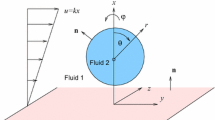Abstract
A numerical method is developed for calculating the non-steady-state motions of a compressible liquid, with application to problems of the impact type. A homogeneous, completely conservative difference scheme of the first order of exactness is used. For isolation of the discontinuities and “smoothing” of the solution, use is made of the introduction of an artificial viscosity, based on an analysis of the provisional properties of the solution. An investigation is made of the scheme stability and the necessary stability criteria are obtained. The article gives the detailed results of a calculation of the impact interaction between a spherical drop and a rigid surface. It is shown that the maximal pressure arising with the impact of a drop of liquid on a solid surface exceeds by several times the pressurecalculated using the one-dimensional theory; under these circumstances, the rate of expansion of the drop along the surface exceeds the initial velocity of the collision by an order of magnitude.
Similar content being viewed by others
Literature cited
R. G. Perel'man, “Calculation of pressures with a collision between a drop and a plane,” Izv. Vyssh. Uchebn. Zaved., Mashinostr., No. 7 (1968).
O. G. Engel, “Waterdrop collisions with solid surfaces,” J. Res. Nat. Bur. Stand.,54, No. 5 (1955).
J. H. Brunton and J. J. Camus, “The flow of a drop during impact,” in: Proceedings of the Third International Conference on Rain Erosion and Associated Phenomena, Elvatham Hall, August, 1970, Royal Aircraft Establishment, England (1970).
K. H. Joliffe, “The application of dislocation etching techniques to the study of liquid impacts,” Philos. Trans. R. Soc. London, Ser. A,260, No. 1110 (1966).
F. P. Bowden and J. E. Field, “The brittle fracture of solids by liquid impact, by solid impact, and by shock,” Proc. R. Soc., Ser. A,282 (1964).
F. J. Heymann, “High-speed impact between a liquid drop and a solid surface,” J. Appl. Phys.,40, No. 13 (1969).
Huang, Khémmit, and Yang, “Hydrodynamic phenomena with a high-speed collision between a drop of liquid and a rigid surface,” Trans. ASME, Theor. Principles Eng. Calc.,95, No. 2 (1973).
L. J. Briggs, “Limiting negative pressure of water,” J. Appl. Phys.,21, No. 7 (1950).
A. A. Samarskii and Yu. P. Popov, Difference Schemes in Gasdynamies [in Russian], Nauka, Moscow (1975).
R. D. Richtmyer and K. W. Morton, Difference Methods for Initial Value Problems, 2nd ed., Wiley-Interscience (1967).
V. F. Nokh, “Combined Euler-Lagrange (CEL) method for calculation of non-steady-state two-dimensional problems,” in: Calculating Methods in Hydrodynamics [Russian translation], Mir, Moscow (1967).
M. L. Wilkins, “Calculation of elastoplastic flows,” in: Calculating Methods in Hydrodynamics [Russian translation], Mir, Moscow (1967).
Author information
Authors and Affiliations
Additional information
Translated from Izvestiya Akademii Nauk SSSR, Mekhanika Zhidkosti i Gaza, No. 1, pp. 36–43, January–February, 1978.
In conclusion, the authors thank G. G. Chernyi for his continuing interest and his valuable evaluation of the results of the work, and L. F. Shaikhatarov, who participated in making the calculations.
Rights and permissions
About this article
Cite this article
Gonor, A.L., Yakovlev, V.Y. Dynamics of the impact of a drop on a solid surface. Fluid Dyn 13, 25–31 (1978). https://doi.org/10.1007/BF01094455
Received:
Issue Date:
DOI: https://doi.org/10.1007/BF01094455



